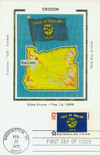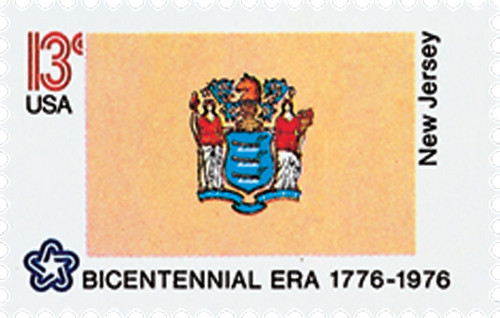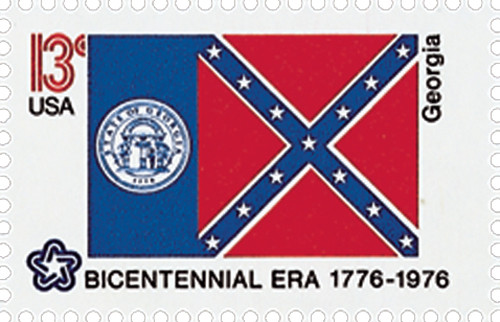
# 1665 - 1976 13c State Flags: Oregon
U.S. 1665
1976 Oregon
State Flags
American Bicentennial Series
• First time a sheet 50 had all different stamp designs
• Part of the American Bicentennial Series
Stamp Category: Commemorative
Series: American Bicentennial Series
Value: 13¢ First-class postage rate
First Day of Issue: February 23, 1976
First Day City(s): Washington, DC
Quantity Issued: 8,720,100 (panes of 50)
Printed by: Bureau of Engraving and Printing
Printing Method: Photogravure
Format: Sheet of 50
Perforations: 11
Why the stamp was issued:
The United States Postal Service celebrated the American Bicentennial with a full pane of the Union’s fifty state flags.
About the stamp design:
The flag of Oregon is the only U.S. state flag with different pictures on each side. Both sides have a field of navy blue with design in gold. The reverse pictures the state animal, the beaver. The front picture includes a heart shaped shield with an eagle on top, circled by thirty-three stars representing the number of states in 1859 when Oregon was granted statehood.
The shield pictures the sun setting over the Pacific Ocean, mountains, forests and a covered wagon. A plow, wheat and pickax represent farming and mining. Two ships representing trade appear –a British ship leaving and a United States ship arriving. The eagle represents the United States. The banner is inscribed "The Union" representing Oregon’s support for the United States. Finally, the flag is featuring the words "State of Oregon" and the date of statehood "1859" below.
About the printing process:
Printed by the Bureau of Engraving and Printing on their seven-color Andreotti gravure press (601) which was their work horse for multicolored stamps.
About the American Bicentennial Series:
In the 1970s, America celebrated its 200th anniversary with hundreds of national events commemorating the heroes and historic events that led to our nation’s independence from Great Britain. The U.S. Postal Service issued 113 commemorative stamps over a six-year period in honor of the U.S. bicentennial, beginning with the American Revolution Bicentennial Commission Emblem stamp (U.S. #1432). As a group, the Bicentennial Series chronicles one of our nation’s most important chapters, and remembers the events and patriots who made the U.S. a world model for liberty.
Several of the stamps honored colonial life – craftsmen and communication. Other stamps honored important battles including Lexington and Concord, Bunker Hill, and Saratoga. Significant events such as the Boston Tea Party, the meeting of the First Continental Congress, and the Declaration of Independence were featured as well. The stamps also honored many significant people such as George Washington, Sybil Ludington, Salem Poor, and the Marquis de Lafayette.
Many of the stamps feature classic artwork. For instance, the set of four souvenir sheets picture important events recreated by noted artists such as John Trumbull. The Bicentennial Series also includes an important US postal first – the first 50-stamp se-tenant – featuring all 50 state flags. The format proved to be popular with collectors, and has been repeated many times since.
The American Bicentennial Series is packed with important US history – it tells the story of our nation’s fight for independence through stamps.
History the stamp represents:
On February 14, 1859, Oregon became the 33rd state in the Union.
There was a large population of American Indians living in Oregon when the first Europeans arrived. These tribes included the Chinook, Clackama, Kalapuya, Multnomah, Tillamook, Bannock, Cayuse, Paiute, Umatilla (a major band of the Nez Perce), Klamath, and Rogue.
Spanish sailors traveling from the Philippines to Mexico were probably the first whites to spot the coast of Oregon. In 1579, Sir Francis Drake may have reached Oregon’s southern coast while searching for a water route from the Pacific Ocean to the Atlantic Ocean. British explorer James Cook sailed into Yaquina Bay in 1778. American ships reached the Oregon coast in 1788. In 1792, Captain Robert Gray, an American, was the first European to explore the Columbia River. Gray named the river after his ship. The Lewis and Clark Expedition traveled by land to the mouth of the Columbia River in 1805. These explorations gave the United States solid grounds for claiming the Oregon region.
on this area.
American fur trader John Jacob Astor began white settlement of Oregon when he established a fur trading company at Astoria. After the War of 1812, Great Britain took control of Astoria. In 1825, the British Hudson Bay Company established Fort Vancouver at the site of today’s Vancouver, Washington. John McLoughlin served as head of the firm for 20 years – which basically meant he ruled the region. McLoughlin later became a US citizen. He played a key role in the settlement of the state and is today remembered as the “father of Oregon.”
Methodist missionaries at Willamette Valley created the first permanent American settlement in Oregon in 1834. After this settlement was established, hundreds of Americans began pouring into the area every year. This put pressure on the US and Britain to settle their boundary dispute. In 1844, James K. Polk ran for the US presidency, based on a campaign stating that land south of 54º 40’ belonged to the US. The slogan “Fifty-Four Forty or Fight” became a big part of his campaign. Polk was elected President, and in 1846, he signed a treaty with Great Britain fixing the 49th parallel as the main dividing line between the territories of the two nations.
During the second half of the 19th century, there were a series of bitter wars fought between American Indian tribes and whites. In 1847, Indians massacred Marcus Whitman and 13 others near today’s Walla Walla, Washington. This sparked the Cayuse War (1847-48). Gold was discovered in southwest Oregon in the early 1850s, and white miners flocked to the area. A series of conflicts between miners and Indians led to the Rogue River Indian War, which ended in 1856. The Indians were forced into a reservation. The Modoc Indian War lasted from November 1872 to June 1873.
Oregon settlers organized a provisional government in 1843. They adopted a set of laws patterned after those of Iowa. In 1848, Oregon became a territory. Oregon City served as the capital until 1850, when it was moved to Salem. In 1853, the Washington Territory was created, and Oregon received the same boundaries it has today.
The territory grew fast after the attractive Donation Land Law of 1850 was passed. This law gave 320 acres of land to any US citizen over 18. A settler’s wife could also receive 320 acres. The settler had to cultivate the land for a minimum of four years to qualify for ownership. Starting December 1850, and until December 1855, settlers received 160 acres of land and had to be over 21 years old.
Oregon achieved statehood on February 14, 1859. Salem served as the capital city and John Whiteaker became the first governor.
U.S. 1665
1976 Oregon
State Flags
American Bicentennial Series
• First time a sheet 50 had all different stamp designs
• Part of the American Bicentennial Series
Stamp Category: Commemorative
Series: American Bicentennial Series
Value: 13¢ First-class postage rate
First Day of Issue: February 23, 1976
First Day City(s): Washington, DC
Quantity Issued: 8,720,100 (panes of 50)
Printed by: Bureau of Engraving and Printing
Printing Method: Photogravure
Format: Sheet of 50
Perforations: 11
Why the stamp was issued:
The United States Postal Service celebrated the American Bicentennial with a full pane of the Union’s fifty state flags.
About the stamp design:
The flag of Oregon is the only U.S. state flag with different pictures on each side. Both sides have a field of navy blue with design in gold. The reverse pictures the state animal, the beaver. The front picture includes a heart shaped shield with an eagle on top, circled by thirty-three stars representing the number of states in 1859 when Oregon was granted statehood.
The shield pictures the sun setting over the Pacific Ocean, mountains, forests and a covered wagon. A plow, wheat and pickax represent farming and mining. Two ships representing trade appear –a British ship leaving and a United States ship arriving. The eagle represents the United States. The banner is inscribed "The Union" representing Oregon’s support for the United States. Finally, the flag is featuring the words "State of Oregon" and the date of statehood "1859" below.
About the printing process:
Printed by the Bureau of Engraving and Printing on their seven-color Andreotti gravure press (601) which was their work horse for multicolored stamps.
About the American Bicentennial Series:
In the 1970s, America celebrated its 200th anniversary with hundreds of national events commemorating the heroes and historic events that led to our nation’s independence from Great Britain. The U.S. Postal Service issued 113 commemorative stamps over a six-year period in honor of the U.S. bicentennial, beginning with the American Revolution Bicentennial Commission Emblem stamp (U.S. #1432). As a group, the Bicentennial Series chronicles one of our nation’s most important chapters, and remembers the events and patriots who made the U.S. a world model for liberty.
Several of the stamps honored colonial life – craftsmen and communication. Other stamps honored important battles including Lexington and Concord, Bunker Hill, and Saratoga. Significant events such as the Boston Tea Party, the meeting of the First Continental Congress, and the Declaration of Independence were featured as well. The stamps also honored many significant people such as George Washington, Sybil Ludington, Salem Poor, and the Marquis de Lafayette.
Many of the stamps feature classic artwork. For instance, the set of four souvenir sheets picture important events recreated by noted artists such as John Trumbull. The Bicentennial Series also includes an important US postal first – the first 50-stamp se-tenant – featuring all 50 state flags. The format proved to be popular with collectors, and has been repeated many times since.
The American Bicentennial Series is packed with important US history – it tells the story of our nation’s fight for independence through stamps.
History the stamp represents:
On February 14, 1859, Oregon became the 33rd state in the Union.
There was a large population of American Indians living in Oregon when the first Europeans arrived. These tribes included the Chinook, Clackama, Kalapuya, Multnomah, Tillamook, Bannock, Cayuse, Paiute, Umatilla (a major band of the Nez Perce), Klamath, and Rogue.
Spanish sailors traveling from the Philippines to Mexico were probably the first whites to spot the coast of Oregon. In 1579, Sir Francis Drake may have reached Oregon’s southern coast while searching for a water route from the Pacific Ocean to the Atlantic Ocean. British explorer James Cook sailed into Yaquina Bay in 1778. American ships reached the Oregon coast in 1788. In 1792, Captain Robert Gray, an American, was the first European to explore the Columbia River. Gray named the river after his ship. The Lewis and Clark Expedition traveled by land to the mouth of the Columbia River in 1805. These explorations gave the United States solid grounds for claiming the Oregon region.
on this area.
American fur trader John Jacob Astor began white settlement of Oregon when he established a fur trading company at Astoria. After the War of 1812, Great Britain took control of Astoria. In 1825, the British Hudson Bay Company established Fort Vancouver at the site of today’s Vancouver, Washington. John McLoughlin served as head of the firm for 20 years – which basically meant he ruled the region. McLoughlin later became a US citizen. He played a key role in the settlement of the state and is today remembered as the “father of Oregon.”
Methodist missionaries at Willamette Valley created the first permanent American settlement in Oregon in 1834. After this settlement was established, hundreds of Americans began pouring into the area every year. This put pressure on the US and Britain to settle their boundary dispute. In 1844, James K. Polk ran for the US presidency, based on a campaign stating that land south of 54º 40’ belonged to the US. The slogan “Fifty-Four Forty or Fight” became a big part of his campaign. Polk was elected President, and in 1846, he signed a treaty with Great Britain fixing the 49th parallel as the main dividing line between the territories of the two nations.
During the second half of the 19th century, there were a series of bitter wars fought between American Indian tribes and whites. In 1847, Indians massacred Marcus Whitman and 13 others near today’s Walla Walla, Washington. This sparked the Cayuse War (1847-48). Gold was discovered in southwest Oregon in the early 1850s, and white miners flocked to the area. A series of conflicts between miners and Indians led to the Rogue River Indian War, which ended in 1856. The Indians were forced into a reservation. The Modoc Indian War lasted from November 1872 to June 1873.
Oregon settlers organized a provisional government in 1843. They adopted a set of laws patterned after those of Iowa. In 1848, Oregon became a territory. Oregon City served as the capital until 1850, when it was moved to Salem. In 1853, the Washington Territory was created, and Oregon received the same boundaries it has today.
The territory grew fast after the attractive Donation Land Law of 1850 was passed. This law gave 320 acres of land to any US citizen over 18. A settler’s wife could also receive 320 acres. The settler had to cultivate the land for a minimum of four years to qualify for ownership. Starting December 1850, and until December 1855, settlers received 160 acres of land and had to be over 21 years old.
Oregon achieved statehood on February 14, 1859. Salem served as the capital city and John Whiteaker became the first governor.


















